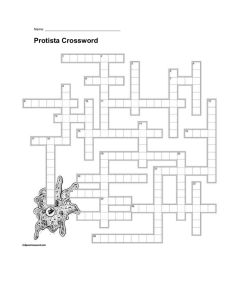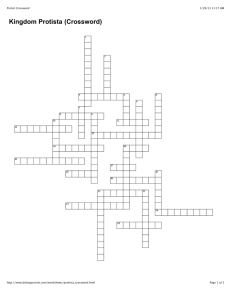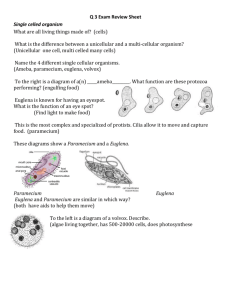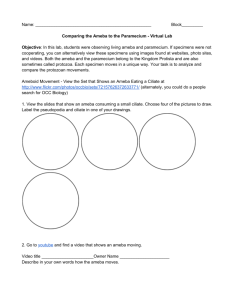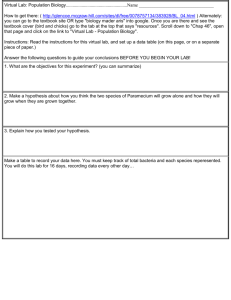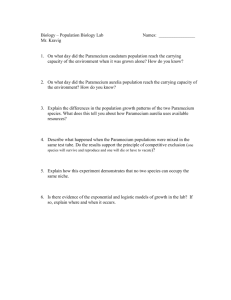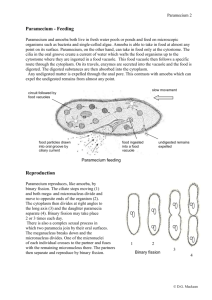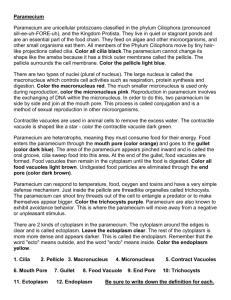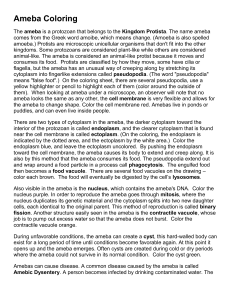Protist Lab
advertisement
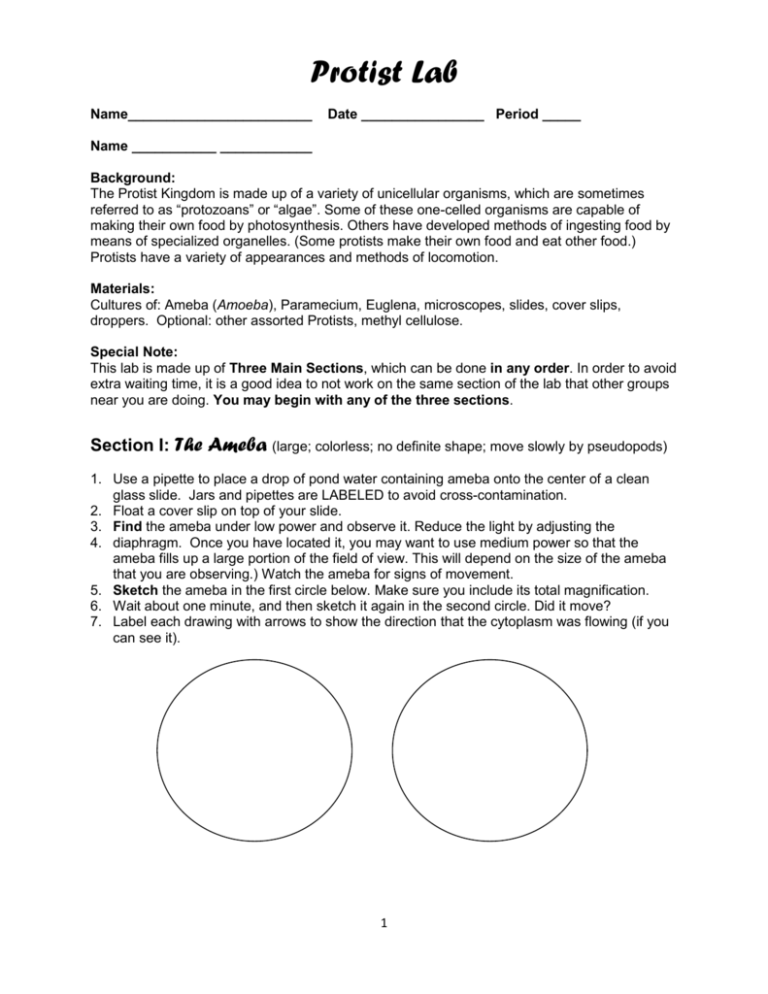
Protist Lab Name________________________ Date ________________ Period _____ Name ___________ ____________ Background: The Protist Kingdom is made up of a variety of unicellular organisms, which are sometimes referred to as “protozoans” or “algae”. Some of these one-celled organisms are capable of making their own food by photosynthesis. Others have developed methods of ingesting food by means of specialized organelles. (Some protists make their own food and eat other food.) Protists have a variety of appearances and methods of locomotion. Materials: Cultures of: Ameba (Amoeba), Paramecium, Euglena, microscopes, slides, cover slips, droppers. Optional: other assorted Protists, methyl cellulose. Special Note: This lab is made up of Three Main Sections, which can be done in any order. In order to avoid extra waiting time, it is a good idea to not work on the same section of the lab that other groups near you are doing. You may begin with any of the three sections. Section I: The Ameba (large; colorless; no definite shape; move slowly by pseudopods) 1. Use a pipette to place a drop of pond water containing ameba onto the center of a clean glass slide. Jars and pipettes are LABELED to avoid cross-contamination. 2. Float a cover slip on top of your slide. 3. Find the ameba under low power and observe it. Reduce the light by adjusting the 4. diaphragm. Once you have located it, you may want to use medium power so that the ameba fills up a large portion of the field of view. This will depend on the size of the ameba that you are observing.) Watch the ameba for signs of movement. 5. Sketch the ameba in the first circle below. Make sure you include its total magnification. 6. Wait about one minute, and then sketch it again in the second circle. Did it move? 7. Label each drawing with arrows to show the direction that the cytoplasm was flowing (if you can see it). 1 Protist Lab IF YOU CAN’T FIND A LIVE AMEBA, ASK YOUR INSTRUCTOR FOR A STAINED, PREPARED SLIDE (DEAD) TO DRAW IN ONE OF THE CIRCLES. 8. Look up contractile vacuole in your textbook, and define it in your own words: 9. The ameba’s contractile vacuole appears as a clear circle. Look at your ameba and try to find what looks like a small bubble inside. If you find it, label it. 10. Look up the word pseudopod in your textbook, and define it in your own words: 11. After an ameba has engulfed its food, a food vacuole is formed. Look at the ameba in the microscope, and try to find a vacuole with material inside. (Do not confuse it with the nucleus, which is the largest dark object in the ameba.) Label it if you can see it. 12. Below, draw a picture of the ameba from your textbook, labeling the following: pseudopod, nucleus, cell membrane, cytoplasm, contractile vacuole and food vacuole. 13. Wash you ameba down the drain and clean off your slide and cover slip thoroughly. Return any prepared (stained, fixed) slides to your teacher. Section II: The Paramecium (medium size; clear; slipper-shaped; move quickly by cilia) Look up the word cilium in your textbook, and define it in your own words: 1. Use the dropper in the paramecium culture to get a drop of “scum” out of the container, and place it on a microscope slide. Place a cover slip on top of the mixture. Optional: you can slow the protist down by adding one drop of methyl cellulose on top of the paramecium (this is a “syrup” that makes it hard for them to swim). 2. Find a paramecium under low power and observe it. Then, change to medium power to see the details of the paramecium better. 2 Protist Lab Reduce the light by adjusting the diaphragm. You may need to move the slide to keep the paramecium in the field of view. 3. Carefully draw the paramecium in the circle below (include magnification power). IF YOU CAN’T FIND A LIVE PARAMECIUM, ASK YOUR INSTRUCTOR FOR A STAINED, PREPARED SLIDE (DEAD) TO DRAW. 4. Look up contractile vacuole in your textbook, and define it in your own words: 5. The paramecium’s contractile vacuoles appear as star-shaped structures at each end. Try to find the contractile vacuoles in your specimen. Label them if you can see them. 6. To eat, a paramecium collects food in its oral groove. When it has eaten, a food vacuole is formed. Look at the paramecium in the microscope, and try to find a vacuole with material inside. (Do not confuse it with the nucleus, which is the largest dark object in the paramecium.) 7. Below, draw a picture of paramecium from your textbook, labeling the following: cilia, nucleus (macro/micro), cell membrane, pellicle, oral groove, cytoplasm, contractile vacuole and food vacuole. 3 Protist Lab 8. Wash the paramecium down the drain. Wash and dry the slide and cover slip. Section III: The Euglena (small; green; oval; move quickly by flagellum) 1. Look up the word flagellum in your textbook, and define it in your own words: 2. Use the dropper in the euglena culture to get a drop out of the container, and place it on a microscope slide. Place a cover slip on top of the drop. 3. Find euglena under low power and observe them. Shift to high power, and get a closer look. 4. Carefully draw a few euglena in the circle below. Include magnification power. IF YOU CAN’T FIND A LIVE EUGLENA, ASK YOUR INSTRUCTOR FOR A STAINED, PREPARED SLIDE (DEAD) TO DRAW. 5. Look up chloroplast in your textbook, and define it in your own words: 6. The euglenas’ chloroplasts appear as green objects inside the cells. Euglenas make their own food by photosynthesis, but may also eat if they choose to or if sunlight is not available. 7. Below, draw a picture of euglena from your textbook, labeling the following: flagellum, nucleus, chloroplasts, cell membrane, pellicle, eyespot & cytoplasm 4 Protist Lab 8. Wash the euglenas down the drain. Wash and dry the slide and cover slip. 5
